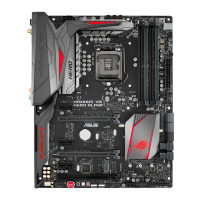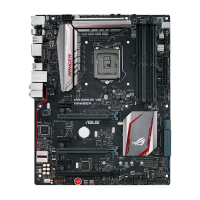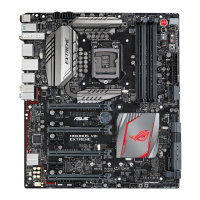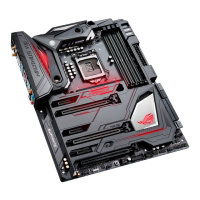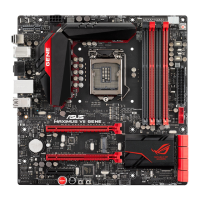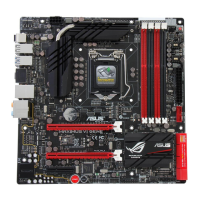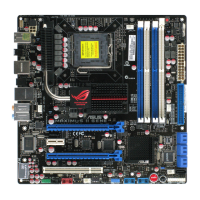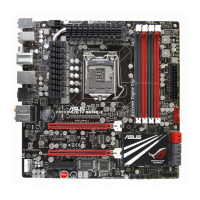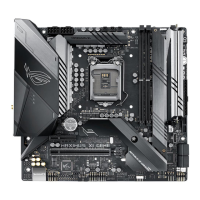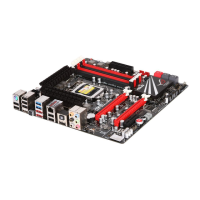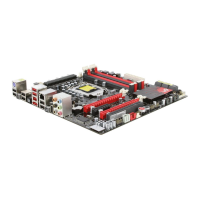Do you have a question about the Asus MAXIMUS VIII GENE and is the answer not in the manual?
Precautions to prevent electrical shock hazards during system handling.
Guidelines for safe handling and operation of the motherboard and components.
Overview of the manual's structure and content sections.
Resources for additional product and software information.
Explanation of text formatting conventions like bold, italics, and key notation.
Details about the CPU socket and supported processors.
Information on the Intel Z170 Express Chipset.
Specifications for DDR4 memory support and XMP.
Details on PCIe slots and their configurations.
Information on integrated graphics and multi-VGA output support.
Support for NVIDIA SLI and AMD CrossFireX technologies.
Details on SATA and M.2 storage interfaces and RAID support.
Information about the Intel Gigabit LAN controller and features.
Details on ROG SupremeFX 2015 audio CODEC and features.
Specifications for USB 3.1 and USB 2.0 ports and controllers.
List of unique ROG features like buttons, LN2 mode, RAMDisk.
Overview of key UEFI BIOS features and utilities.
Details on ASUS Dual Intelligent Processors 5 and exclusive features.
List of ASUS specific software and hardware features.
Features for easy system building and maintenance like BIOS flashback.
ASUS design features for easier installation and diagnostics.
Listing of all rear panel connectors and their functions.
Details on various internal headers and connectors for system components.
List of supported BIOS standards and features.
Information on system management features like WOL and PXE.
List of bundled software and drivers.
Supported Windows OS versions.
Physical dimensions and form factor of the motherboard.
Lists items included in the motherboard package.
Lists the ROG motherboard support DVD.
Lists the user guide.
Standard screws for PC assembly.
Tool for screw fastening.
The computer case for housing components.
Component providing power to the system.
The central processing unit for the motherboard.
Cooling solution for the CPU.
Memory modules for the system.
Storage device for data.
Optional drive for reading discs.
Optional component for video output.
Highlights key features of the motherboard.
Overview of the 'Republic of Gamers' philosophy and core features.
Details on CPU socket compatibility and memory controllers.
Information on the chipset's design and performance benefits.
Explanation of PCIe 3.0 standard and its performance advantages.
Support for multi-GPU configurations for gaming.
Details on M.2 slot compatibility for PCIe and SATA modes.
Benefits of USB 3.0 accessibility for front and rear panels.
Highlights gaming-specific audio and networking features.
Details on the 8-channel high-definition audio CODEC.
Audio enhancement for in-game sound awareness.
Audio tuning software for virtual surround sound.
Automatic detection and adjustment for headphone impedance.
Network management software for prioritizing traffic.
High-performance LAN solution with advanced features.
Details on ROG-specific hardware and software enhancements.
Power delivery components for overclocking and extreme gaming.
Technology to cache data for faster game loading.
Software to create a virtual drive using system memory.
Microprocessor for keyboard upgrades and macros.
Features provided by ASUS utilities and technologies.
All-in-one software for system supervision and control.
Technology to accelerate USB transfer speeds.
Hassle-free BIOS updating solution.
List and description of included ROG software.
Antivirus software for system protection.
Overlay for gaming, communication, and streaming.
Software for backing up and emulating discs.
Customized utility for system information.
DRAM efficiency tool for timing analysis.
Audio technology for surround sound and home theater.
General overview of the motherboard layout and components.
Important precautions before installing components.
Diagram and labeling of motherboard components and connectors.
Table listing connectors, jumpers, buttons, and slots with page references.
Details on CPU installation and socket compatibility.
Information on DDR4 DIMM slots and installation.
Guidelines for installing and configuring memory modules.
List of qualified DDR4 memory modules for 3600+ MHz.
List of qualified DDR4 memory modules for 3400 MHz.
List of qualified DDR4 memory modules for 3333 MHz.
List of qualified DDR4 memory modules for 3300 MHz.
List of qualified DDR4 memory modules for 3200 MHz.
List of qualified DDR4 memory modules for 3000 MHz.
List of qualified DDR4 memory modules for 2800 MHz.
List of qualified DDR4 memory modules for 2666 MHz.
List of qualified DDR4 memory modules for 2400 MHz.
List of qualified DDR4 memory modules for 2133 MHz.
Additional details on DDR4 2133 MHz memory and side support.
Diagram and description of PCIe slots.
Table showing IRQ assignments for various devices.
PCIe operating modes for single and dual GPU setups.
Explanation of motherboard's onboard buttons like Power and Reset.
Function of the ReTry button for overclocking.
Function of the Safe Boot button for BIOS recovery.
How to use the MemOK! button for memory compatibility.
Explanation of onboard LEDs like Hard Disk LED and Q LEDs.
Indicates PCH voltage and PLL voltage status.
Two-digit error code display for system status.
Table of Q-Code error codes and their descriptions.
Continuation of Q-Code error codes and their descriptions.
Further Q-Code error codes and their meanings.
Final part of the Q-Code table with more error codes.
Additional Q-Code entries and ACPI/ASL Checkpoints.
Details on jumpers, specifically the LN2 Mode jumper.
Function of the LN2 Mode jumper for cold-boot bug.
Overview of internal connectors on the motherboard.
Details on SATA connectors and RAID configuration.
Information on connecting USB 3.0 modules for additional ports.
Details on connecting USB 2.0 modules for front panel ports.
Connector for chassis-mounted front panel audio module.
Connectors for various fans and water pumps.
Details on connecting ATX power supply to the motherboard.
Connector for chassis-mounted functions like power/reset buttons and LEDs.
Connector for OC Panel and other ROG devices.
Connector for thermistor cables to monitor temperature.
Details on M.2 socket compatibility and SATA port sharing.
Using ProbeIt points to detect system voltage and OC settings.
General steps for assembling a PC.
Steps for installing the motherboard into the PC chassis.
Securing the motherboard with screws and safety warning.
Step-by-step guide for installing the CPU into the socket.
Final steps and warnings for CPU installation.
Instructions for installing the CPU cooler.
Steps for uninstalling the CPU heatsink and fan.
Guide for installing and removing memory modules (DIMMs).
How to connect the ATX power supply cables.
Instructions for connecting SATA hard drives and optical drives.
Connecting front panel connectors like USB and audio.
Guide for installing PCIe x16 cards.
Information on updating the BIOS using USB BIOS Flashback.
Overview of rear panel I/O ports.
Detailed listing and identification of rear panel connectors.
Further details on rear panel connectors and LAN LED indications.
Pin assignments for different audio channel configurations.
Diagrams showing audio port connections for various speaker setups.
Visual guides for connecting headphones, mics, and speakers.
Visual guides for connecting different speaker configurations.
Steps for the initial system power-on and POST.
Table of BIOS beep codes and their meanings.
Procedures for shutting down or putting the system to sleep.
Introduction to BIOS and its function in system configuration.
How to enter and navigate the BIOS setup utility.
Method to access BIOS before the OS loads.
Alternative methods to access BIOS after system initialization.
Overview of BIOS menu structure and modes (EZ/Advanced).
Description of the EZ Mode interface and its functions.
Overview of the Advanced Mode for detailed BIOS configuration.
Explanation of the main menu items in the BIOS interface.
Description of each main menu category (My Favorites, Main, etc.).
How submenus are displayed and navigated.
Option to change the BIOS display language.
Feature to save and access frequently used BIOS settings.
Controls for fan speed and behavior.
Wizard for automatic system tuning and overclocking.
Utility for adding notes within the BIOS.
Navigation keys used in the BIOS setup program.
How to navigate through menu items that exceed screen limits.
On-screen descriptions of selected BIOS items.
How to view and change BIOS setting values.
Shows recently changed BIOS settings.
Personalizing BIOS by saving favorite items.
Steps to add frequently used BIOS items to the My Favorites menu.
Overview of system information and basic settings in the Main menu.
Options for configuring system security settings and passwords.
Setting and managing administrator passwords for BIOS access.
Setting and managing user passwords for BIOS access.
Menu for configuring overclocking-related settings.
Options for CPU overclocking, including Auto, Manual, and XMP.
Setting the Base Clock (BCLK) frequency for system performance.
Maximizing performance with ASUS core ratio settings.
Setting CPU core ratio limits and synchronization.
Enabling/disabling odd ratio for better memory granularity.
Setting DRAM timing parameters for performance tuning.
Setting the memory operating frequency.
Feature to improve benchmark performance.
Automatic overclocking for CPU and DRAM frequencies and voltage.
Minimum power consumption settings for energy saving.
Controlling CPU communication with external voltage regulator.
Setting DRAM clock period.
Enabling or disabling memory scrambler support.
Enabling or disabling Channel A DIMM slots.
Enabling or disabling Channel B DIMM slots.
Enhancing system stability or DRAM overclocking capability.
Setting values for memory overclocking.
VRM Initialization Check and CPU Load-line Calibration.
Setting total power range for CPU overclocking.
Affects VRM response speed and thermal production.
Setting higher frequency for quicker transient response.
Enhancing system stability.
Adjusting VRM current and thermal conditions.
Setting power phase control for the CPU.
Wider CPU power thermal range for overclocking tolerance.
Configuring voltages for CPU, DMI, Core PLL, System Agent, VCCIO at initial boot.
Setting CPU ratio and features like SpeedStep and Turbo Mode.
Settings for Turbo Ratio duration and package power time window.
Setting AC loadline values.
Setting DC loadline values.
Advanced overclocking options including BCLK settings.
Setting DRAM VTT voltage.
Setting VPPDDR voltage.
Setting DMI voltage.
Setting Core PLL voltage.
Selecting PLL bandwidth for overclocking.
Setting eventual DRAM voltage.
Setting eventual CPU standby voltage.
Setting eventual PLL termination voltage.
Preventing throttling during overclocking.
Preventing throttling for CPU graphics during overclocking.
Setting the minimum CPU cache ratio.
Setting the maximum CPU cache ratio.
Setting the CPU graphics ratio.
Configuring CPU core/cache voltage modes.
Manually configuring CPU core voltage.
Configuring CPU core voltage offset.
Configuring CPU core voltage offset for Turbo Mode.
Configuring CPU core voltage offset.
Setting DRAM voltage.
Setting CPU VCCIO voltage.
Setting CPU System Agent voltage.
Setting PLL termination voltage.
Setting PCH core voltage.
Configuring CPU graphics voltage modes.
Manually configuring CPU graphics voltage.
Configuring CPU graphics voltage offset.
Setting CPU standby voltage.
Configuring DRAM reference voltages.
Menu for configuring CPU and other system devices.
Menu to view CPU-related information automatically detected by BIOS.
Selecting the number of CPU cores to activate.
Enabling virtualization capabilities.
Enabling or disabling the MLC streamer prefetcher.
Enabling or prefetching adjacent cache lines.
Selecting CPU performance state during system boot.
Managing CPU power settings like SpeedStep and Turbo Mode.
Setting power saving states for the CPU.
Configuring platform-related features.
Enhancing PCI-E power saving.
Controlling Active State Power Management (ASPM).
DMI Link ASPM Control for Power Management on SA side of DMI link.
Selecting ASPM level for energy saving.
DMI Link ASPM Control and PEG ASPM settings.
Configuring System Agent settings.
Enabling virtualization technology on memory control hub.
Selecting primary display from graphical devices.
Enabling integrated and discrete graphics for multi-monitor output.
Configuring DMI/OPI settings.
Configuring PEG Port settings and link speeds.
Controlling onboard LEDs and ROG Audio LED.
Configuring PCH settings, including PCI Express.
Configuring PCI Express slots and speeds.
Automatically selecting PCI Express port speed.
Configuring SATA devices and RAID settings.
Enabling 'ASUS Hyper kit' card or M.2 devices.
Enabling or disabling SATA devices.
Setting SATA configuration to AHCI or RAID.
Enabling or disabling PCIE port to SATA for RAID.
Enabling or disabling SATA Express PCIE port to SATA for RAID.
Enabling or disabling PCIE_X4_1 port to SATA for RAID.
Monitoring system for hard disk errors during POST.
Enabling Link Power Management for energy saving.
Enabling or disabling selected SATA ports.
Enabling or disabling SATA Hot Plug Support.
Configuring USB-related features.
Enabling support for USB devices on legacy OS.
EHCI support by XHCI drivers in operating systems.
Enabling or disabling individual USB ports.
Enabling or disabling the UEFI network stack.
Enabling or disabling the UEFI network stack.
Enabling or disabling IPv4/IPv6 PXE boot option.
Configuring onboard devices.
Enabling or disabling the High Definition Audio controller.
Setting PCI Express x4 slot bandwidth.
Enabling or disabling the ASMedia USB 3.1 Controller.
Enabling or disabling ASMedia USB 3.1 Battery Charging Support.
Auto-detecting or always-on power for USB Type C devices.
Enabling or disabling the Intel LAN Controller.
Enabling or disabling Intel LAN preboot execution environment.
Configuring Advanced Power Management settings.
Switching off power for ErP requirement.
System state after AC power loss.
Powering on via PS/2 keyboard.
Wake-on-LAN function for onboard LAN or PCI-E cards.
Generating wake events using the real-time clock.
Displays SMART information of connected storage devices.
Displays system temperature, power status, and fan settings.
Automatically detecting fan speeds and configuring duty cycles.
Controls CPU fan speed based on type and mode.
Setting fan performance levels (Standard, Silent, Turbo, Manual).
Controlling chassis fans in DC or PWM mode.
Setting CPU fan step-up time.
Setting CPU fan step-down time.
Setting chassis fan performance levels.
Controlling extension fans in DC or PWM mode.
Setting extension fan performance levels.
Controlling water pump speed in DC or PWM mode.
Enabling Over Voltage and Under Voltage Protection.
Changing system boot options.
Accelerating system boot speed.
Setting boot behavior after power loss.
Adjusting boot logo size or hiding it.
Selecting waiting time for POST report.
Setting additional POST waiting time to enter BIOS Setup.
Setting the power-on state of NumLock.
Enabling or disabling 64-bit device decoding in above 4G address space.
Pausing system until F1 is pressed on error.
Showing or hiding Option ROM messages during POST.
Executing trap right away or during legacy boot.
Switching between Advanced Mode and EZ Mode.
Configuring CSM for better compatibility with VGA, devices.
Auto-detecting or enabling CSM for non-UEFI devices.
Selecting boot device types (UEFI, Legacy).
Selecting network device boot type.
Selecting storage device boot type.
Selecting PCI-E/PCI expansion device boot type.
Configuring Windows Secure Boot settings and managing keys.
Selecting installed OS type for Secure Boot.
Managing Secure Boot keys (PK, KEK, DB).
Clearing default Secure Boot keys.
Saving Platform Keys (PK) to USB.
Loading or deleting the PK file.
Managing Key Exchange Keys (KEK).
Managing DB files for image loading.
Managing DBX files for image loading.
Specifying boot device priority sequence.
Starting boot from selected available devices.
Accessing Windows Safe Mode or selecting boot device.
Accessing options for special functions.
Enabling or disabling the Setup Animator.
Utility for updating the BIOS.
Safely cleaning SSDs to restore factory performance.
Information on Secure Erase, its status definitions, and limitations.
Storing and loading multiple BIOS settings.
Inputting and saving values for CPU core voltage, BCLK, etc.
Viewing DRAM SPD information.
Displaying information about the installed graphics card.
Information and configuration for PCIe slots used by graphics cards.
Selecting the bus interface for graphics cards.
Loading default values, saving, or discarding changes.
Loading default BIOS settings.
Saving selected BIOS settings and resetting the system.
Exiting BIOS without saving changes.
Attempting to launch EFI Shell from filesystem devices.
Information on updating the motherboard BIOS.
Utility for updating BIOS in Windows environment.
Updating BIOS using a USB flash drive.
Restoring BIOS from support DVD or USB flash drive.
Updating BIOS in DOS environment.
Steps for updating BIOS using the DOS updater.
Confirming BIOS update and restarting the computer.
General guidance on OS installation.
Guide for preloading USB 3.0 drivers for Win 7 install.
Installing Windows 7 using support DVD and USB devices.
Installing Windows 7 using a modified ISO image.
Creating a modified Windows 7 installation source with EZ Installer.
Steps for creating bootable USB or ISO with EZ Installer.
Steps for creating ISO and burning to DVD.
Installing modified Windows 7 from DVD or USB.
Information about the contents of the support DVD.
Instructions on how to launch the support DVD utility.
How to find and access software manuals from the support DVD.
Overview of applications on the support DVD.
Introduction to ASUS AI Suite 3 and its integrated utilities.
Steps to install AI Suite 3 on Windows 7.
Installing AI Suite 3 on Windows 8/8.1/10 and launching it.
Overview of AI Suite 3 main menu and its quick-access bar.
Overview of ASUS DIP 5 features for system optimization.
Dynamically optimizes PC for best system status.
Manually adjusting CPU frequency, cache, and voltages.
How to use TPU for CPU frequency and voltage adjustments.
Adjusting CPU graphics voltage for performance.
Real-time system power-saving chip for energy optimization.
Configuring EPU settings for power saving.
Digital VRM and DRAM Voltage controllers for system efficiency.
Adjusting phase number for thermal performance and efficiency.
Enabling spread spectrum for system stability.
Adjusting voltage range for system performance or power efficiency.
Wider total power range for overclocking.
Wider thermal range for overclocking tolerance.
Adjusting VRM current and thermal conditions.
Customizable fan settings for cooling and quiet operation.
Auto Tuning feature for CPU and chassis fans.
Customizing system performance, network priority, and audio for applications.
Displays all running applications on the system.
Displays applications added to the Turbo App List.
Fast charging for portable devices via USB.
Automatically speeds up USB transfer rates using UASP.
Connecting USB 3.0/3.1 devices to supported ports.
Utility for updating software, drivers, or BIOS.
Displays detailed information on motherboard, CPU, and memory.
Accessing motherboard details via the MB tab.
Accessing CPU details via the CPU tab.
Accessing memory information via the SPD tab.
Sharing PC keyboard/mouse or streaming audio with smart devices.
Interface for Mobo Connect settings.
Utility for system status alerts and messages to smart devices.
Steps to launch Push Notice application.
Interface for setting up PC mode and status alerts.
Steps to pair computer and smart device for Push Notice.
Configuring alerts for PC restart, shutdown, sleep modes.
Sending alerts for unusual voltage, temperature, or fan settings.
Sending messages via Push Notice.
Checking computer status via Push Notice on smart device.
Information on ROG audio features and software.
Steps to install Realtek Audio Manager driver.
Audio suite with six controls for virtual surround sound.
Adjusting audio frequencies for music preference.
Configuring advanced equalizer settings.
Selecting preset equalizer profiles.
Enhancing bass effects in audio.
Enhancing voice clarity for communication and dialogues.
Automatically adjusting EQ for deep bass and high frequencies.
Recreating multichannel listening experience.
Increasing spaciousness and selecting reverb presets.
Selecting reverb effects from environmental spaces.
Playing a test tone for selected preset profile.
Choosing preset profiles like Gaming, Music, or Movie.
Registering, opening, or resetting audio profiles.
Toggling Sonic Studio function ON/OFF.
Adjusting volume of connected devices.
Changing language or viewing tutorial.
Features for voice enhancement like Volume Stabilizer and Noise Gate.
Toggling Perfect Voice for own voice ON/OFF.
Toggling Perfect Voice for incoming voice ON/OFF.
Enabling Volume Stabilizer for own or incoming voice.
Removing background noise from voice.
Removing remaining voice from audio.
Resetting voice settings to default.
Starting test for selected preset profile.
Choosing Noise Gate mode (Auto or Manual).
Enhancing streaming and recording quality.
Built-in headphone AMP adjusting to headphone impedance.
Speaker configuration and headphone impedance display.
Delivering surround sound and connecting PC to home theater.
Game feature showing precise direction and intensity of sound.
Customizing game settings like Transparency and Signal.
Configuring shortcut keys for Sonic Radar II.
Configuring sound enhancers for audio modes.
Network management software with preset packet priority profiles.
Prioritizing game packets and optimizing others.
Giving game packets top priority.
Giving media-streaming packets top priority.
Giving file-sharing packets top priority.
Displays top 5 bandwidth consuming applications.
Lists the top 5 bandwidth consuming applications.
Displays individual download/upload bandwidth of applications.
Displays total download/upload bandwidth of applications.
Testing internet speed or manually setting upload/download speeds.
Displays physical network card details like IP address.
Keyboard upgrade with macros and BIOS access.
Interface for configuring keyboard functions.
Feature for smart input and macro assignment.
Assigning functions to keyboard keys.
Creating keyboard shortcuts for specific tasks.
Streaming PC multimedia content to smart devices.
Launching Media Streamer on PC and smart device.
Managing media files for streaming.
Software to create a high-speed virtual drive using system memory.
Steps to create and manage RAMDisk drives.
Procedures to delete or format an existing RAMDisk drive.
Creating links to remap contents into RAMDisk.
Manually synchronizing updates with RAMDisk backup files.
Software to view and validate memory timings.
Launching the MemTweakIt application.
Online and manual validation and saving of configuration.
Utility for gathering and displaying system information in ROG layout.
Software to increase PC performance by utilizing unused system memory.
Steps to launch RAMCache and select cache size.
Information on RAID 0, 1, 10, and 5 configurations.
Optimal installation of identical drives for RAID arrays.
Enabling RAID function in BIOS Setup before creating RAID sets.
Entering the Intel RST Option ROM utility.
Steps to create a RAID set using the Intel RST utility.
Starting the RAID volume creation process.
Naming the RAID set.
Selecting the RAID level for the array.
Selecting physical disks for the RAID set.
Selecting drives, stripe size, capacity, and creating the volume.
Cautious procedure for deleting a RAID set and its data.
Initiating the RAID volume deletion process.
Steps to exit the Intel RST utility.
Requirement for a floppy disk with RAID drivers for OS installation.
Steps to create a RAID driver disk from BIOS.
Steps to create a RAID driver disk using Windows.
Installing the RAID driver during OS setup.
FCC statements regarding device compliance and interference.
FCC compliance information for Class B digital devices.
Canadian compliance statements and regulations.
Statement on digital apparatus radio noise limits.
Japan compliance statement for Class B ITE.
Warning statement for Korean compliance.
Information on REACH compliance and chemical substances.
Information on responsible recycling of products and components.
Terms of use for Google software components.
CE Declaration of Conformity for English language users.
CE Declaration of Conformity for Portuguese users.
CE Declaration of Conformity for Romanian users.
CE Declaration of Conformity for Serbian users.
CE Declaration of Conformity for Slovak users.
CE Declaration of Conformity for Slovenian users.
CE Declaration of Conformity for Spanish users.
CE Declaration of Conformity for Swedish users.
CE Declaration of Conformity for Ukrainian users.
CE Declaration of Conformity for Turkish users.
CE Declaration of Conformity for Bosnian users.
CE Declaration of Conformity for Croatian users.
CE Declaration of Conformity for Czech users.
CE Declaration of Conformity for Danish users.
CE Declaration of Conformity for Dutch users.
CE Declaration of Conformity for Estonian users.
CE Declaration of Conformity for Finnish users.
CE Declaration of Conformity for Greek users.
CE Declaration of Conformity for Hungarian users.
CE Declaration of Conformity for Latvian users.
CE Declaration of Conformity for Lithuanian users.
CE Declaration of Conformity for Norwegian users.
CE Declaration of Conformity for Polish users.
Contact details for ASUS support in various regions.
Manufacturer's declaration of conformity with EU directives.
FCC Declaration of Conformity for product compliance.
| Form Factor | Micro ATX |
|---|---|
| Socket | LGA 1151 |
| Chipset | Intel Z170 |
| Memory Slots | 4 |
| Maximum Memory | 64 GB |
| SATA 6Gb/s | 6 |
| USB 3.0 (Gen1) | 6 |
| RAID Support | 0, 1, 5, 10 |
| PCI Express x1 | 1 |
| M.2 | 1 |
| USB 3.1 (Gen2) | 1 (Type-A), 1 (Type-C) |
| USB 2.0 | 6 |
| LAN | Intel I219V Gigabit LAN |
| Audio | 8-Channel HD Audio |
| Multi-GPU Support | NVIDIA 2-Way SLI, AMD 3-Way CrossFireX |
